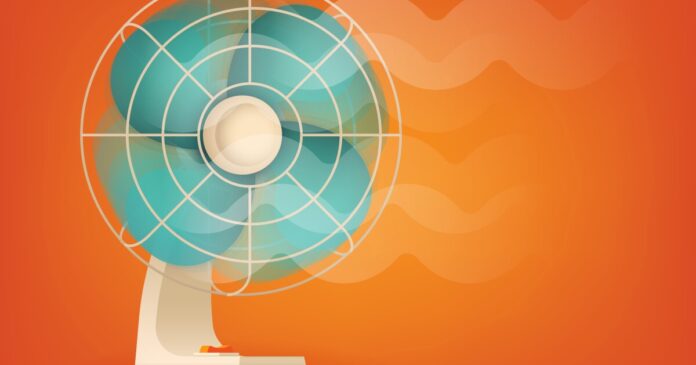A fan might feel like a lifeline in a heatwave, and for older adults it may be of some help – but not as much as it might seem. A new study has found that while high-speed fan use slightly reduced core body temperature and improved comfort in humid heat, it doesn’t stop internal heat buildup entirely. And in extremely hot and dry conditions, where fan use has previously been shown to raise heart strain, it can do more harm than good.
Researchers from Australia’s University of Sydney, Monash University, the University of Adelaide, along with the Montreal Heart Institute, investigated the effect of electric fan use during different temperature conditions on a cohort of 58 older adults aged 60 years and over (mean age 68 years).
In the randomized crossover trial, 27 participants had a history of coronary artery disease, while 31 did not. All participants underwent four three-hour heat exposures separated by at least 72 hours: Fan only (around 4 m/s airflow), skin wetting without fan, skin wetting with fan and no intervention (control). The fan was placed just over three feet (1 m) from the subject.
In the skin-wetting sessions, warm water was misted onto the exposed skin of participants to simulate sweat. And the fan used was a standard high-speed household pedestal unit.
The participants were exposed to ambient room temperatures of 100.4 °F (38 °C) with 60% relative humidity, representing high indoor heatwave conditions.
The researchers found that fan use alone slightly reduced core body temperature of participants by an average of 0.18 °F (0.1 °C), compared to no fan or skin wetting, showing some benefit of using a high-speed electric fan. There was an increase in sweating, too, and people reported feeling cooler and more comfortable.
Interestingly, using a fan with skin wetting didn’t change core body temperature, though it did make people feel the most comfortable overall. The research suggests that the skin wetting suppressed natural sweat responses that remove heat from the body.
And skin wetting alone did nothing to shift core body temperature, even if people reported they felt a little more comfortable than during the control heat exposure.
However, when it came to different temperatures and humidity, the results were flipped. Given the risk to heart issues in people with coronary artery disease, only the 31 healthy participants took part in the fan study (the remaining 27 individuals just underwent skin wetting/no skin wetting conditions).
What they found was that in hot and dry conditions – 113 °F (45 °C) with 15% humidity – using a fan alone actually increased core body temperature by 0.5 °F (0.3 °C), showing that fan actually drove heat into the body, compared to not using a fan at all. Neither skin wetting tests proved significant in cooling down participants.
And people also reported they felt hotter using the fan in this test, showing that as their core temperature rose, their comfort levels reflected the internal shift.
Overall, the study shows that it’s not just the temperature number but the water content in the air that determines how well a high-speed electric fan is going to work in actually cooling the body.
The link between heat exposure and cardiovascular disease is well documented, with a large body of evidence showing how higher temperatures can put the heart under increased strain. Risk of heart-related death has been shown to triple when the mercury rises during a heat wave.
Earlier research from the University of Sydney and the Montreal Heart Institute found that accessible interventions such as wetting the skin was able to negate the heating effect of fans when temperatures and air dryness resulted in heating the body. In this study, however, a slight drop in core temperature wasn’t statistically significant, so its benefits are negligible even if it is perceived as more comfortable.
The study suggests that a fan may not be enough to negate health risks during a heatwave, and for those without access to an air-conditioner, other interventions like community cooling shelters and more nuanced heat risk warnings could better protect older adults during extreme weather events.
The research was published in the journal JAMA Network Open.
Source: The University of Sydney via Scimex


